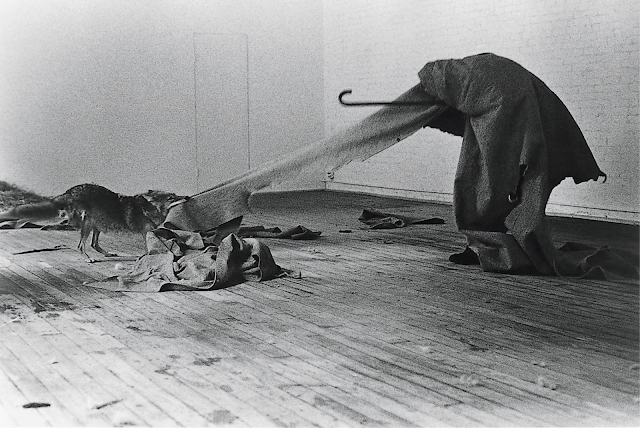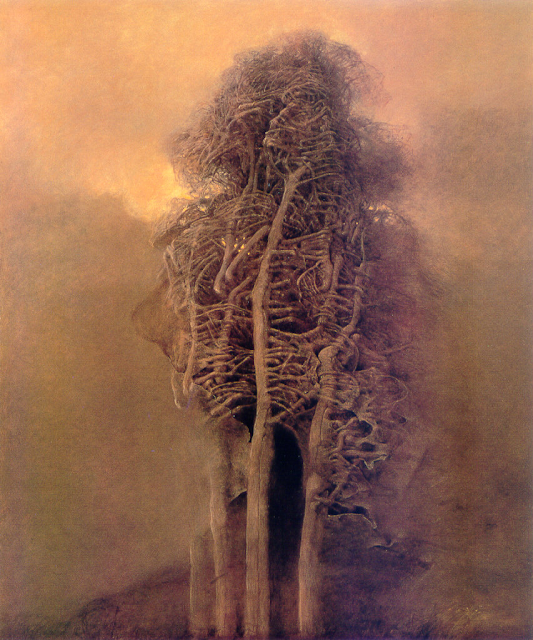Throw out the science fictions about intelligent robots. To understand AI art we don't need to get lost in press release fantasies, we need to understand the century-old art that paved the way for Dall-E.
If GAN and other procedural forms of art seem to demand new forms of criticism, we might have to give up on them coming from the arts press. They're busy and distracted imagining they're in a cyberpunk video game, which hey, I'll grant, seems a lot more fun than the kind of story we're really in (think: Catch 22, or maybe something by Vonnegut).
Maybe you didn't catch this from my lengthy diatribe on boredom last time, but I can't get very excited about debates around artificial intelligence anymore. Like so many questions posed by futurists and science fiction writers--"is the identical copy of you that comes out the other side of a teleporter still technically you?"--it seems predicated on assumptions about human nature I'm skeptical of (i.e. as an autistic traumatized transsexual, "continuity of self" is already a dodgy proposition. You're fretting over whether your atoms have been replaced by other, identically positioned atoms? Gosh that must be so hard for you).
What strikes me as odd about the breathless fixation in the arts press on these science fiction critiques is that it's not just deeply uncritical of tech company press releases, but also has totally forgotten the last century of art history! Like, Jean Arp when he dropped pieces of torn paper onto a canvas and recorded their placement "according to the laws of chance" didn't have to resolve questions of the scrap paper's intelligence. A half century later when Earth Artists began working with leaves, soil, gravel, and plants, they did not seek to model the minds of the rocks. Now we've got a solid hundred years of stochastic methods and the creation of art that by design will change over time without the intervention of the artist's "intent". Why is so little of that history referenced when discussing what is, ultimately, a very advanced processor for random scraps of paper dropped on a very complex canvas?
Last time I talked a lot about the audience and curators whose agency directs and defines "AI art". Now I want to talk about the other side, the algorithms themselves and their agency. I'm not interested in debating whether they're "intelligent", though, because I don't think they need to be intelligent to be *agonists*--to be things with agency to act on the world.
Does this seem weird, or even outrageous? I'm not sure I'd go as far as Ligotti and say that "human beings... have an unfalteringly good opinion of themselves", but certainly a lot of Americans think of themselves as the protagonists--or prime-agonists?-of reality. Yet. I find persuasive the ideas of Jane Bennett in Vibrant Matter that things have an agency all their own. Is that paired with a certain autistic tendency toward empathy and (over?) identification with objects? Eh, probably. But I don't think that a sense of a tree or a series of rocks as active participants in the creation of an artwork represents a kind of woolly spiritualism, but an honest and straightforward materialism, a recognition that things will do what they will do according to THEIR physical natures, not just perform at our beck and call. So many of the discussions on AI art fall back on questions of things like the Soul of the Artist. I'm not sure why simply suggesting that an AI, like a tree, has its own agency to act in accordance with its nature should be treated more mystical than that, given AI's often unexpected recalcitrance as a tool manifests every day in our lives, while the soul's seat in all our meat remains frustratingly elusive.
Moreover, we have seen in increasingly shocking and brutal fashion just how many nonhuman entities have agency over our own lives: the pandemic to a great degree continues unchecked because the leaders of the western world decided that in order to appease one inhuman entity (the stock market), it would be better if we pretended the agency of another (the coronavirus's tendency to mutate and spread) simply didn't matter. Once again, respecting an inhuman entity's agency seems much more materialist than the insane jingoistic anthropomorphism of declaring we must "not let the virus win" by going out and continuing to shop, as if the virus's primary aim was to make us sad! Americans love being the protagonists of reality!
This is the context in which I want to frame and understand works like Joseph Beuys's "I Like America And America Likes Me", a performance where the (German) artist was transported to America and left to spend eight hours a day, for three days, in a gallery space with a wild coyote (also named America). The performance represented a kind of communing between Beuys and the coyote, putting the artist and the animal on a level to interact, rather than a situation of Beuys trying to tame America (the animal not the country). If I'm being a little tongue in cheek with this it's because I'm not sure I buy some of Beuys's shamanism and "healing the western mind" schtick. But there's something about the actual performance that I find captivating:
Maybe it reads against the grain of Beuys's own self-mythologization, but I see this as a dramatically anti-protagonistic performance. What I like about it is precisely the limits of Beuys to control the scenario, just presenting a series of actions which America had agency to respond to, and responding in turn to America's behaviors. Would I lose you if I suggested too that the felt that Beuys wrapped himself in was a "participant" in the sense of having particular materiality that imposed constraints and offered possibilities to the other more traditionally "animate" ones?
Boy, I'm sure I HAVE lost a bunch of people by now, but I'm just trying to express this, again, century old artistic tradition that radically sought to overturn humanity as lords of all creation. It's a tradition that, if you really wanted to, you could trace back all the way to overturning geocentrism with heliocentrism, or overturning Genesis with the Origin of the Species. When artists like Robert Smithson undertook large earth art productions like his masterpiece Spiral Jetty, they understood these were not permanent monuments stamping the world like a trademark. Instead, the materials used to compose them and the surrounding environment were considered active participants in an artistic exploration of entropy and transformation. Even the rocks and sand? Sure--try to command the sand to not rise with the tide to cover the installation, or command the rocks to dig themselves out again, and see how easy it is to make the material world do stuff it doesn't, metaphorically speaking, want to do. The art is for us in some sense, created by humans for a human audience, but the maybe paradoxical message for us as an audience is to recognize the limits of our own ability to control and dictate reality.
I prefer to see AI art, too, as an ongoing negotiation, the art emerging within a network of actors that includes programmers, hardware and its physical properties, perhaps other AIs, a multitude of other artists whose work feeds into the system, prompters, and audiences. You might object and say by this logic, taken to its absurd conclusion, any painting is an ongoing negotiation between a painter and her pigments.
Well... isn't it?
I spend much of my time as an artist trying to better understand the interaction between my intentions and the physical properties of my tools. Understanding the specific physical ways that the alcohol ink in my copics behaves differently than the water based ink in my tombows is essential: each are vibrant and have agency in particular ways. I cannot stop the copic pigment from spreading, and I cannot stop the tombow stroke from overlaying and darkening a prior stroke. I must *negotiate* with the markers to achieve particular effects, and ultimately I must accede, I must surrender, to their agency. I genuinely believe that whether they acknowledge it or not, this process of negotiation is how artists learn their craft. Nothing in the nature of art requires that we view the artist as master and her tools as servants, and some days it can really feel like the relationship flips the other way round!
And yet so much of the discourse around this technology is grounded in hostility. Take GAN art: Generative Adversarial Networks. They operate by a back and forth process, where one "generator" AI throws a bunch of pixels together, and a "discriminator" AI which compares them to actual pictures. Is this adversarial? Why do we characterize this as a "duel"? When Max Ernst took rubbings of wood grain and bark in order to develop his surrealist paintings, was that a "duel" between "adversaries"? Or the construction of an Exquisite Corpse, where artists go around a table with a folded piece of paper and subsequently add onto the drawing without seeing what the others drew before? I'm pretty sure if these processes were antagonistic we'd know about it: the early 20th century avant gardists when they wanted to be antagonistic would just go ahead and start a public brawl. Pointing this out seems impolitic. After all, feminist historians of science in the 80s and 90s dared to suggest metaphors for how say sperm and egg negotiate fertilization distort reality toward chauvinistic stereotypes of male conquest, and STEM proceeded to have a decades long hysterical meltdown about it. Is tech so wedded to these paranoid tendencies to see adversaries and assaults everywhere because of its perverse birth by national defense industries?
Let's leave that question to the psychoanalysts, and leave the question of agency behind, to talk more about the relationship GAN art has to the one good result of psychoanalysis: surrealism.
Lily Alexandre in her coverage of GAN art describes the genre's distinct visual quality in a way that's really stuck with me: she suggests that GAN art is bad at *form* and pretty great at *texture*. Any scrutiny makes the pictures immediately fall apart into nonsense. At a glance, though, they have the feel of the thing being prompted.
This stood out to me specifically because it helped me better understand another subgenre of art: a school of surrealism that similarly focuses on texture. There's some artists in the early school--Max Ernst, Remedios Varo--who have a real textural focus in their work, but I'm particularly interested in later artists, people like Zdzislaw Becksinski, HR Giger, or Sibylle Ruppert. These artists stand out to me as having a particular engagement with the surrealist jolt, the moment of unrecognition we get looking at surrealist artwork. For someone like Rene Magritte (or Dali, nodded to in the GAN DALL-E), the jolt comes from a naturalistic rendering of an impossible or illogical subject. For these artists, it's a little more complicated. They, like GAN programs, play in a space of a breakdown of form paired with a deep rendering of texture. Becksinski is a master of rendering desiccated skin and masses of bone. Ruppert is a master of fatty tissue, swollen muscle, and turgid genitals. Giger will paint recognizable figures at times but they always have a plastic, slightly artificial quality that allows them to merge texturally with his seething grounds of metal and rubber.
No surprise artists in this tradition are such an influence on GAN engineers and prompters. Peppering prompts with references to Becksinski or Giger seems to be a popular and functional way to get images that look, well, relatively good. There's something marvelous in the way AI can now mimic the styles of artists like Van Gogh, but I find that the marvel wears off as every sky, regardless of the source photo, becomes Starry Night. The precision with which someone like Vincent selected colors and contrasts, applied textures, and warped or flattened the geometric planes of his subject is, it turns out, a much more formal question than a textural one.
In contrast, this school of surrealism taps into the pleasure and horror of reaching out and touching something familiar but unfamiliar. It's a very embodied form of surrealism, one that I think invites us to imagine a physical presence of an impossibility or an aberration.
One other surrealist, Dorothea Tanning, is worth looking at in this context. Tanning is a master draughter, she's kind of a god damn genius seemingly capable of doing whatever she wanted across a wide range of styles over her career. So when she turns, in the late 50s and early 60s, towards a kind of hazy abstraction, she ends up producing something that's like where GAN art might head if people wanted to tweak it in that direction: masterfully rendered figures emerge from and slide back into the fog of texture in strange colors.
There's something that I find viscerally unsettling about her work. It's not just the fact that it looks so much like GAN art, like the woman's mind was just running its own internal AIs against each other, though that's definitely part of the jolt I experience. No, it's the sense of things emerging out of the corner of the eye. Of ghosts. Of psychosis. It feels like catching a glimpse as you turn your head of a recently dead loved one. It feels like seeing a bird and having your brain, traumatized, mistake it for a scuttling roach. Is this an unfair gloss on her work? It's not all, or intrinsically, horror. I find it astoundingly beautiful and overwhelming. It's unsettling but also magnetic. I want to understand. I am afraid to.
GAN art, I think, could achieve something like this, if it were pushed aesthetically away from the banal dreams of engineers who can only imagine the machine as a magical genie who conjures up representations at its master's command, and toward something with more latitude to push and pull against a prompt, maybe something that, like Tanning, flowed between states, some areas subject to the exactitude of anatomy and representation, others falling away into textured abstraction. It is a radically different destiny for AI art than the one we seem headed towards, where AI art is merely a biproduct of an ever expanding public-private surveillance regime overseeing a culture that produces nothing but ever more bloated, alienated spectacle.
It says something to me that one of the DALL-E sets of pieces that most attracted me, really blew my socks off, bears the caption "Asking DALL-E 2 for "macro photograph of a pencil made of fish scales" just gets these weird pencil tessellations (pencillations)", the "just" in particular suggesting that this is a sort of error or disappointment:
Particularly when they're all put together, a tetraptych, the variations are arresting. I think that there's two ways of viewing the selected group. One is with the prompt as title. In this case, it becomes an exploration of the machine's attempt to reconcile the surreal juxtaposition of two things that otherwise have never been put together before. (Interestingly, a later attempt by the same prompter at "macro photography of fish scales made of pillows" strikes me as much less interesting, just resulting in what looks like some nicely textured textiles. Too easy, perhaps?) It makes me wonder if a productive method would be to use something like textsynth, or even a dictionary based generator, to generate novel text combinations which are then given to a GAN like DALL-E to frantically interpret. That kind of process excites me; it seems to uncover the collaborative nature of engaging these machines, amounting to a kind of curator-assisted exquisite corpse. In this case, the prompt-bearing interpretation I think suggests a kind of strange biomechanical striving, human designed objects struggling to emulate and replicate the methodologies of living things. Look how the first piece bears a spiral pattern like sunflower seeds, and the third discovers the logic of the honeycomb. It's uncanny. This is art about the liveliness of things.
I can imagine an argument, though, for removing the prompt. In this case, it's impossible to know exactly how "accurate" the GAN was in developing art that matches the prompt. It sidesteps some of the discourse I find so frustrating, the spectacle of tech demo achievement. I think it also opens the piece up to more ambiguity. Do we think first of biomechanical becoming or something else? The number of pencil heads in the second one in particular kind of stresses me out, I imagine the texture, rough and pointed, and all those graphite cores scraping across a surface at once. The last one looks almost like a stinger. The system's adeptness at capturing textural patterns has stumbled upon a genuinely new site of unsettling imagined touch.
I think there's potential, real exciting potential, here. This critical analysis moves on from the boring, frustrating arguments about intelligence and intent, beyond the press release hype, to actually grasp what makes the art... artistic. There's so much power here if we let go of the vice grip we have culturally on the idea that machines--and everything else for that matter!--just exists to be instrumentalized, to jump at command and fulfil our desires!
GAN art HAS a unique aesthetic rooted in art history. And it HAS a theoretical underpinning that likewise goes back years, one that offers an opportunity to reframe our understanding of technology as vibrant--sometimes in ways that are beautiful, other times that are dangerous and demand our respect. We should do all the diverse agonists that participate in its creation the courtesy of taking their art seriously as art.








No comments:
Post a Comment